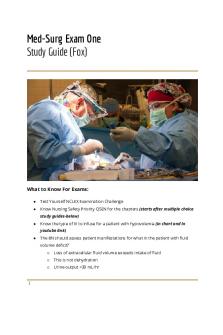Med Surg 2 FINAL EXAM Notes PDF

| Title | Med Surg 2 FINAL EXAM Notes |
|---|---|
| Course | Adaptive Processes - Nursing - Med/Surg 2 |
| Institution | Indiana University - Purdue University Indianapolis |
| Pages | 107 |
| File Size | 2.4 MB |
| File Type | |
| Total Downloads | 9 |
| Total Views | 147 |
Summary
Jennifer Remick and Wendy Zeiher...
Description
Adult perfusion 7-9 questions (heart failure, arrhythmias, medications, ACS, PAD) Perfusion Reduced CO results in a reduction of oxygenated blood reaching the body tissues (systemic effect) o If untreated can lead to ischemia, cell injury, and cell death o Tachycardia = decreased preload o Increased aortic pressure (increased afterload) = decreased stroke volume increased preload Venous system low pressure, high volume o Preload = volume Volume of blood in the ventricles at the end of diastole, before the next contraction Fluid volume in body is a direct correlation to preload Arterial system high pressure, low volume o Afterload = pressure The resistance/force against which the left ventricle must overcome to pump blood out of the ventricle Edema results from an increase in hydrostatic pressure Systole contraction of the myocardium that results in ejection of blood from the ventricles Diastole relaxation of the myocardium that allows the ventricles to fill CO the amount of blood pumped by each ventricle in one minute SV from the left ventricle per beat See med grid for all these meds o Beta blockers o CCB o Alpha/beta blockers o ACE-I o ARBS o Diuretics Who’s at risk for impaired perfusion? o Middle-aged and older adults o Men – they don’t have the estrogen protection factor o African Americans Primary prevention o Smoking cessation – before they start o Diet, exercise, weight control Secondary prevention o BP and lipid screenings Treatment strategies depend on underlying condition; often used: o Diet and smoking cessation o Increased activity o Pharmacotherapy
Cardiac output assessments o Pain, dyspnea, edema, dizziness, fainting What could cause these o Tissue perfusion Sparse hair on lower extremities and cool to the touch Diminishes pulses Decreased UO o Consequences from impaired perfusion r/t conduction disorders are: Dysrhythmias and decreased CO o Parasympathetic NS decreases rate of SA node and slows impulse conduction of AV node o Sympathetic NS increases rate of SA node and increases impulse conduction of AV node and contractility Causes diaphoresis Intrinsic rates: o SA node 60-100 bpm Primary pacemaker o AV node 40-60 bpm o HIS-purkinje system 20-40 bpm ECG monitoring o P wave firing of the SA node and represents depolarization of the aorta 0.12 second o PR interval beginning of P wave until the beginning of QRS complex (not the end of it!) 0.12 - 0.20 second o QRS complex ventricle depolarization 0.04 - 45 (high CO2) & pH < 7.35 (low pH) Causes of respiratory acidosis: COPD Retaining/build-up of CO2 Reduced function/suppression of Respiratory Center Hypoventilation o Leads to a build-up of CO2 Over sedation Drug OD Neurological disorders o Not telling you to breathe Inadequate mechanical ventilation o Treatment is to improve alveolar ventilation Correct the cause, ↑ ventilation & gas exchange
o o
o
Respiratory Alkalosis
PaCO2 < 35 (low CO2) & pH > 7.45 (high pH) Causes of respiratory alkalosis: Hyperventilation Hypoxemia from acute pulmonary disorders Anxiety Pain Respiratory rate setting on vent too high CNS disorders Fever Respiratory stimulant drugs o Symptoms: neuromuscular irritability, vertigo, dizziness o Treatment Treating the underlying cause Rebreathing into bag, decreasing anxiety, turn down respiratory vent o o
o
Step Three: Analyze the HCO3 o Concentration of bicarbonate in the blood Metabolic component of ABG o Normal HCO3: 22-26 Increased: > 26 is alkalosis/base Decreased: < 22 is acidosis
Metabolic Acidosis o o
HCO3 < 22 (low HCO3) & pH < 7.35 (low pH) Causes: GI Loss of bicarbonate from intestine Diarrhea (getting rid of base in intestine), intestinal fistula o Poop out base o Vomit acid DKA Starvation, Malnutrition Renal Failure
Shock – anaerobic metabolism which creates lactic acid and it builds up which causes metabolic acidosis Lactic acidosis due to anaerobic metabolism from shock o Treatment of symptoms Give sodium bicarbonate PO or IV The body tries to compensate by initiating Kussmaul Respirations to get rid of more CO2
o o
Anion Gap - measurement of excessive unmeasurable anions (-) Normal: 8-16 mEq/L Helpful in classification of metabolic acidosis o High anion-gap metabolic acidosis - increase in minor plasma ions ; increase of nonvolatile acids - seen with DKA, lactic acidosis, renal failure, toxins as salicylates o Non-anion-gap metabolic acidosis - loss of bicarbonate and retention of chloride ion (normal anion-gap) - diarrhea, renal failure
Metabolic Alkalosis o o
HCO3 > 26 (high HCO3) & pH > 7.45 (high pH) Causes: Excess bicarbonate, and loss of acid Vomiting or NGT suctioning (removing acid from stomach) Diuretic therapy Diuretics excrete hydrogen ions In an alkalotic state, the body will retain hydrogen ions and excrete bicarb ions (compensatory) If acidotic it will be the opposite^ o Lots of hydrogen ions acidic o High bicarb/low hydrogen basic Loss of Hydrogen, potassium, chloride Antacid administration Excessive ingestion of licorice
o
Treat symptoms and correct cause
o
Change diuretic to acetazolamide (diamox)- kidneys excreted more HCO3, for example o Administer chloride (isotonic saline or KCl) Oxygenation Status – PaO2 o Partial pressure of oxygen in arterial blood (3% od O2sat) o Oxygen dissolved in the blood plasma o Normal PaO2: 80-100 mmHg o Increased: administration of high amount of oxygen o Decreased: hypoxia / not well oxygenated o
Evaluation of ABG Results o Look at pH - normal, acidosis, or alkalosis o Look at PCO2 - normal, acidosis, or alkalosis o Look at the HCO3 (Bicarb) - normal, acidosis, or alkalosis o Look at PaO2 – hypoxemia? o What is the cause (respiratory or metabolic)? o Determine interventions needed
Compensation o Compensates by trying to return the ratio to 20:1 o Respiratory problem: the compensating system is metabolic Meaning, if both pH and PCO2 are acidic then this respiratory acidosis The A’s match and the HCO3 is B o Metabolic problem: the compensating system is respiratory o Respiratory compensation occurs in hours o Kidney compensation takes 2-3 days Compensation – pH returns to Normal o Complete compensation pH is normal PaCO2 & HCO3 are abnormal o Partially compensated ABG pH, PaCO2, & HCO3 are all abnormal (all 3) o Uncompensated ABG pH is abnormal and only one other component (PaCO2 or HCO3) is abnormal - one direct cause for the abnormal pH
Respiratory Acidosis o Uncompensated pH < 7.35 PCO2 > 45 Bicarb 22-26 o Partially Compensated pH < 7.35 PCO2 > 45 Bicarb >26 o Complete compensation pH becomes normal (7.35-7.45) PCO2 > 45 Bicarb >26 May be associated with hypoxia Respiratory Alkalosis o Uncompensated pH > 7.45 PaCO2 < 35 HCO3 Normal o Partially compensated pH > 7.45 PaCO2 < 35 HCO3 < 22 o Compensated PH Normal PaCO2 < 35 HCO3 < 22 Metabolic Acidosis o Uncompensated pH < 7.35 PaCO2 Normal HCO3 < 22 o Partially compensated pH < 7.35 PaCO2 < 35 HCO3 7.45 PaCO2 Normal HCO3 >26 o Partially Compensated pH > 7.45 PaCO2 > 45 HCO3 > 26 o Compensated pH Normal PaCO2 > 45
HCO3 > 26
Assessment for ABG – subjective data o Past health history Involving kidneys, heart, GI system, or lungs Specific diseases such as Diabetes, COPD, renal failure, ulcerative colitis, and Crohn’s disease o Medications Many prescription drugs, including diuretics, corticosteroids, and electrolyte supplements can cause imbalances o Surgery or other treatments Ask about past or present renal dialysis, kidney surgery, or bowel surgery resulting in a colostomy o Health perception/health management plan If the patient is experiencing a problem related to imbalances, obtain a careful description of the illness Including onset, course, and treatment Ask about any recent changes in weight o Nutrition-metabolic plan Ask about current diet and any special dietary guidelines they’re following Assess for eating disorders Assess ability to adhere to the dietary prescription o Elimination pattern Assess normal bowel and bladder habits Note any diarrhea, oliguria, nocturia, polyuria, or incontinence o Activity/exercise pattern Ask about activity pattern and any complaints of excessive perspiration And assess activity level problems that could lead to lack of ability to obtain food or fluids Determine if pt has been exposed to any extremely high temperatures as a result of work or leisure activity Ask what the pt does to replace F&E lost through excessive perspiration o Cognitive-perceptual pattern Ask about any changes in sensations; such as numbness, tingling, twitching, or muscle weakness Ask both the patient and the caregiver if there has been any changes in the pt’s mentation or alertness Such as confusion, memory impairment, or lethargy Assessment of ABG – objective data o Physical examination Complete physical exam is needed because F&E balance affects all body systems o Laboratory values Assessment of serum electrolyte values is a good starting point
However, they reflect the concentration in the ECF and not the ICF o Potassium is mostly in the ICF, so changes in K+ may be the result of a true imbalance Abnormal serum sodium may reflect a water problem Lab tests that help find a risk for imbalances: Serum and urine osmolality, serum glucose, blood urea nitrogen, serum creatinine, venous blood gas sampling, urine specific gravity, and urine electrolytes
COPD
Defining features o Irreversible airflow limitations Mucus hyper secretion Mucosal edema (inflammation, which is the primary process) Of airways, parenchyma (bronchioles and alveoli), and pulmonary blood vessels o May lead to pulmonary HTN The end result is structural changes in the lungs Bronchospasm o Airflow obstruction Inability to expire are Volume of residual air is increased b/c protease is breaking the alveolar attachments to small airways This causes the chest wall to hyper-expand barrel chest Pulmonary HTN may occur late in the course of COPD o Smaller pulmonary arteries constrict due to hypoxia o The patient has inhalation of air, but there’s destruction of the sacs so the exchange of gases here is not efficient They lose the elastic recoil which leads to air trapping and retaining CO2 o Anti-protease prevents breakdown of normal tissue Exposure to noxious gases makes the body release oxidants This produces protease which breaks down the connective tissues in the lungs Signs and symptoms: o Dyspnea o Productive cough o Presence of sputum o Nonspecific complaints of malaise, insomnia, fatigue, depression, confusion, decreased exercise tolerance, increased wheezing, fever without other cause Occurrence is higher in men than women o Fewer men die from COPD than women o Women have more exacerbations Causes of COPD:
o Smoking (#1) The smoke causes hyperplasia of the goblet cells and produces more mucus Hyperplasia reduces airways diameter and increases the difficulty in clearing secretions Cilia lining the airway dies – this is why the COPD has a terrible productive in the morning because all the gunk is sitting in the lungs o Pollution / gases from job sites o Repeated respiratory infections o Pts with asthma may develop COPD o Older age – loss of elastic recoil, stiffening of chest wall, decrease in exercise tolerance, gas exchange alteration Number of functional alveoli decreases as the peripheral airways lose supporting tissues Surface area for gas exchange decreases and the PaO2 decreases o Alpha one antitrypsin deficiency – genetic link/risk factor for COPD So someone can have no risk factors but still develop COPD because of this genetic link Asthma and COPD are both caused by obstruction (and/or inflammation), but the obstruction with asthma is reversible, and COPD is not o Asthma is from inflammation Once the irritant is removed, the lungs return to normal o COPD is from obstruction Breakdown of normal tissue and causes permanent damage If the pt removes the irritant early in the diagnosis, Common characteristics of COPD o Chronic bronchitis If pt has a productive cough at least 3-month period in two consecutive years (diagnostic) Increased mucus and chronic inflammation with destruction and enlargement of air sacs o Emphysema Barrel chest Hyperinflation/hypertrophy o Most patients with COPD have some form of both of the above Some will have one or the other but all cases are treated as if the COPD patient has both chronic bronchitis and emphysema Patient presentation o Cough – usually productive Chronic intermittent cough – often the first symptom to develop o Sputum production Discolored (yellow) or clear
o Weight loss/anorexia/cachectic (muscle wasting, low BMI) o Progressive dyspnea Early – SOB fatigue and dyspnea In late stages, there will be dyspnea at rest’ more alveoli become overdistened, increasing amounts of air being trapped Causing a flattened diaphragm Person becomes more of a chest breather relying on the intercostal muscles and accessory muscles – which is not effecient o Wheezing or decreased breath sounds / rhonchi Inflammation of lungs, trapping of air – wheezing, musical sounds Rhonchi – snoring sound because you have irritants trying to move through secretions o Tripod positional, pursed-lip breathing Sitting forward and holding themselves up on arms while breathing PLB – prolonged expiration and prevent lung collapse and air trapping It will slow RR Do not puff out cheeks Patient with COPD has dyspnea with an increased RR with excessive accessory muscle use o Hypoxemia Polycythemia Body’s concentration of hemoglobin etc is low because of inadequate oxygen exchange, so the body compensated by producing more – which really isn’t all that good… High hematocrit hemoglobin and RBC blood is more viscous and increases risk for clots and stroke o May be pinkish in color o Must address these problems they’re what our nursing care is centered around Classification and diagnosis for COPD: Level of severity - (corresponding with the FEV1 below) o Mild o Moderate o Severe o Very severe FEV1 results (post bronchodilator) o FEV1 ≥ 80% Predicted o FEV1 50%-80% Predicted o FEV1 30%-50% Predicted o FEV1 < 30% Predicted o < 70% diagnosis of COPD
FEV1 is to measure airway obstruction o Forced expiratory volume in 1 second o “predicted” is what we expect in a person with a certain size and certain age People with COPD have air trapping so the worse their COPD is, the worse the air trapping, and the lower their FEV1 percentage is o Spirometry (the golden test to diagnose COPD) looks at FEV1 “pulmonary function test” Need to be without a bronchodilator for 6-8 hours before taking the test for baseline Then they will be given a bronchodilator. Once it takes effect, they will repeat the test Even with the bronchodilator, the results will hardly change (because the obstruction is irreversible/permanent) (in asthma, the FEV1 will increase because the obstruction is reversible) Avoid scheduling right after meal times Assess for pulmonary distress before and after Chest x-ray o See over-inflation of lungs and flattening of diaphragm o Implications of flattened diaphragm effects stomach (pushing on it) and makes stomach a little smaller (less room for food which contributes to their weight loss) GERD may manifest Will also have less room for inhalation of air CT scan – used to diagnose a pulmonary embolism o Push fluids before and after procedure Ventilation/perfusion (V/Q scan) o Used to assess ventilation and perfusion of lungs o IV radioisotope given to assess the perfusion aspect of it o Inhale radioactive gas (xenon or krypton) to assess the ventilation portion o Ventilation without perfusion suggests a pulmonary embolism COPD assessment test (CAT) o Impact of COPD has on ADL Modified Medical Research Council (mMRC) Dyspnea Scale o Measuring pt’s level of dyspnea Gas exchange – complications o Acute respiratory failure Chronic tx with beta blockers may improve survival and reduce risk of future exacerbations o COPD exacerbations Important to identify when a patient may be at risk for developing exacerbations
Increase in sputum production or increase in SOB or increase in symptoms of URI – need to see doctor These are symptoms of a respiratory infection/failure Exacerbation, a lot of the time, is caused by infection May end up with pulmonary HTN And Cor Pumonale (r/t right-sided HF) o Right ventricle will hypertrophy because of increased afterload (pulmonary HTN) o Shows as dyspnea, edema in feet/ankles, jugular vein distention, hepatomeagaly, etc o Treatment of cor pumonale is initially focused on treating COPD (maybe a bronchodilator) Continuous low-flow oxygen improves survival Diuretics may be used So, its important to look for S&S ^^ of right-sided HF (especially later stages of COPD) o Conceptual care for gas exchange: Goals: O2 sat > 90% PaPO2 >60
Oxygen toxicity – high amounts for a long time causes inflammation and obstruct airway Absorption atelectasis – don’t want to give high levels of oxygen because there’s nitrogen in lungs and high amounts will blow out the nitrogen and cause airways collapse CO2 Narcosis – May not feel the need to breathe due to extra oxygen COPD patients develop a tolerance to higher CO2 levels High levels of oxygen is not always contraindicated though If patient is intubated End-stage COPD
Fatigue, sleep disturbances, and dyspnea are common complaints of pts with COPD Dyspnea is the only one that causes interference with ADL So focus interventions on improving dyspnea
Drug therapy o Commonly used bronchodilators Beta 2 Adrenergic agonists (short-acting inhalers) albuterol – PRN Mild to moderate COPD Can help with exercise Take 30 minutes prior to eating o Won’t help a whole lot though otherwise, because COPD is irreversible damage, unlike asthma when it reverses the obstruction right away
o
o
o
o o
Anticholinergic (short-acting for acute) Not asthma. Just COPD Relax and enlarge (dilate) the airways in the lungs, making breathing easier (bronchodilators). o They may protect the airways from spasms that can suddenly cause the airway to become narrower (bronchospasm) and may reduce the amount of mucus produced by the airways. Ipratropium (Atrovent) Albuterol or ipratropium either separately or nebulized together Long-acting anticholinergic Tiotropium (Spiriva) given to COPD patients as a bronchodilator one a day (long-acting) Inhaled corticosteroid therapy (ICS) Used for moderate to severe cases To help with inflammation ICS are not used alone for COPD – will add with LABA “-one” drugs LABA Used in moderate stage (< 60% FEV1) Salmeterol Formoterol Indacaterol The addition of ICS (inhaled corticosteroid therapy) to LABA therapy is often prescribed to COPD pt’s with FEV1 < 60% (moderate) Fluticasone/salmeterol (Advair) Budesonide/formoterol (symbicort) Oral corticosteroids should only be for short-term use to treat exacerbations Roflumilast (daliresp) is an oral Phosphodiesterase inhibitor which suppresses the release of inflammatory cytokines It reduces the frequency of exacerbations Beta blockers help with this too
Upper airway drugs: o Decongestan...
Similar Free PDFs

Med Surg 2 FINAL EXAM Notes
- 107 Pages

Med Surg Final exam review
- 12 Pages

Med surg final - Lecture notes
- 41 Pages

MED SURG EXAM 3-2
- 54 Pages

Med Surg Exam 3
- 19 Pages

Final Exam Practice Qs - Med Surg
- 19 Pages

Exam 2 Med Surg 2 Practice Questions
- 16 Pages
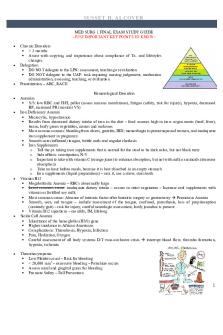
MED SURG 1 Final EXAM Study Guide
- 10 Pages

Med Surg final exam review by me
- 23 Pages

Med surg II final exam fall 2018
- 36 Pages
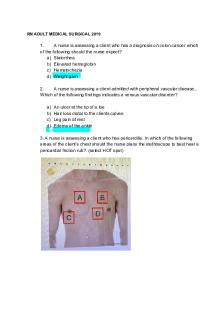
Med surg - notes
- 28 Pages

Med Surg 2 Final Study Guide
- 25 Pages
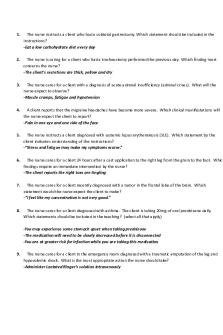
Kaplan med surg 2
- 8 Pages
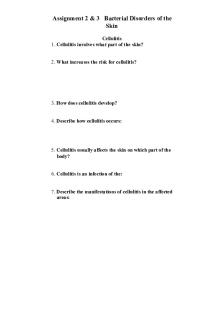
Med SURG; assignment 2
- 9 Pages
Popular Institutions
- Tinajero National High School - Annex
- Politeknik Caltex Riau
- Yokohama City University
- SGT University
- University of Al-Qadisiyah
- Divine Word College of Vigan
- Techniek College Rotterdam
- Universidade de Santiago
- Universiti Teknologi MARA Cawangan Johor Kampus Pasir Gudang
- Poltekkes Kemenkes Yogyakarta
- Baguio City National High School
- Colegio san marcos
- preparatoria uno
- Centro de Bachillerato Tecnológico Industrial y de Servicios No. 107
- Dalian Maritime University
- Quang Trung Secondary School
- Colegio Tecnológico en Informática
- Corporación Regional de Educación Superior
- Grupo CEDVA
- Dar Al Uloom University
- Centro de Estudios Preuniversitarios de la Universidad Nacional de Ingeniería
- 上智大学
- Aakash International School, Nuna Majara
- San Felipe Neri Catholic School
- Kang Chiao International School - New Taipei City
- Misamis Occidental National High School
- Institución Educativa Escuela Normal Juan Ladrilleros
- Kolehiyo ng Pantukan
- Batanes State College
- Instituto Continental
- Sekolah Menengah Kejuruan Kesehatan Kaltara (Tarakan)
- Colegio de La Inmaculada Concepcion - Cebu

